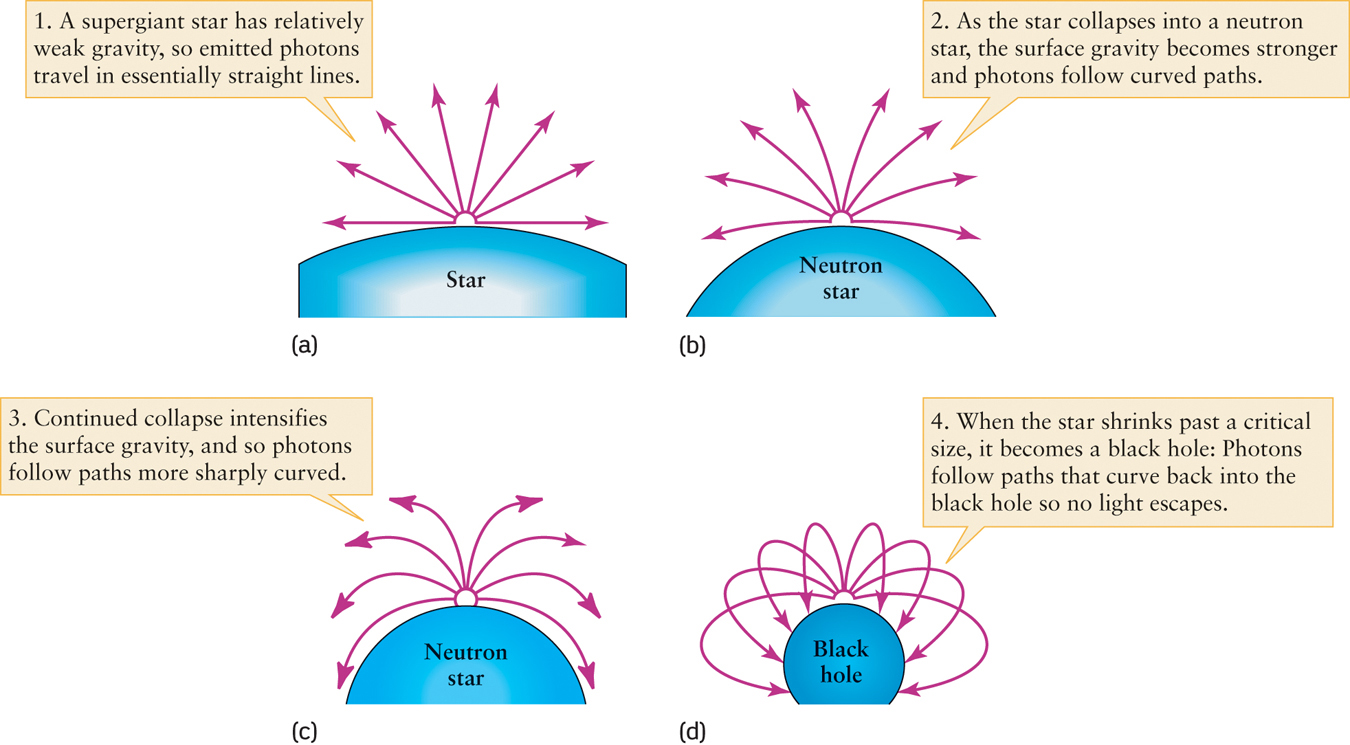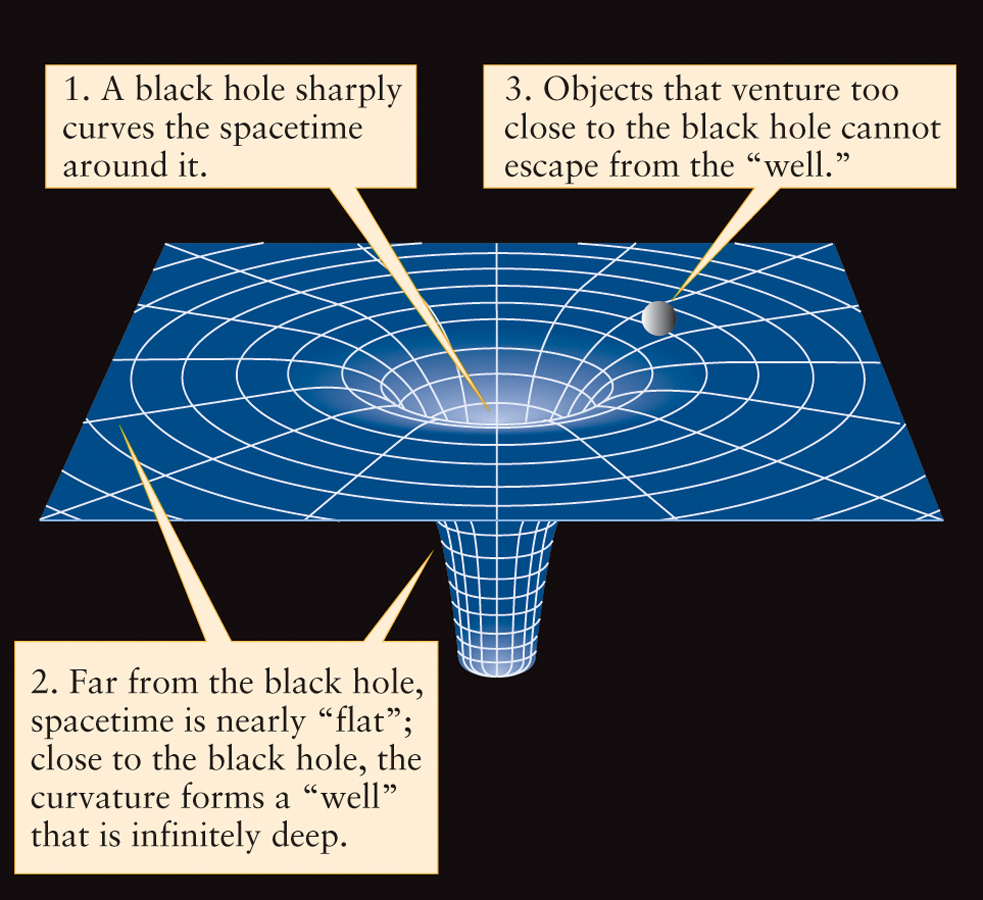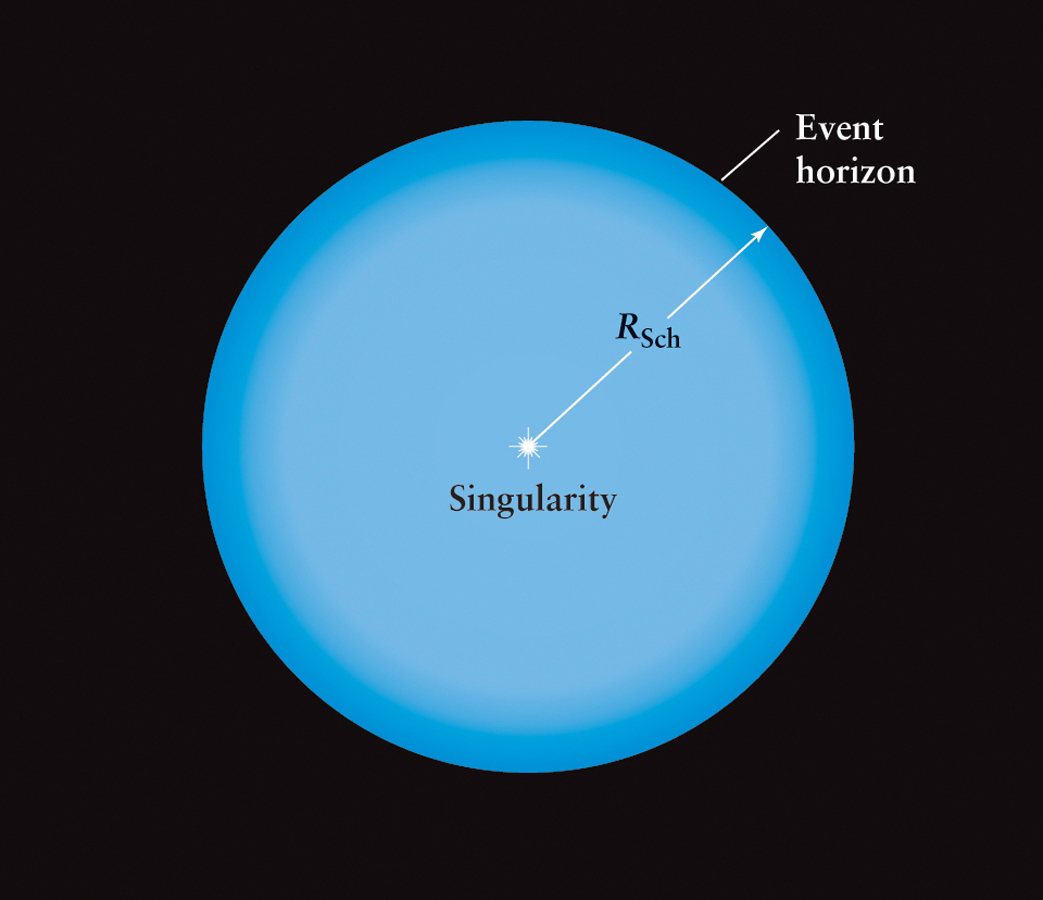12-3 Black holes are created in the death throes of the most massive of stars
 Go to Video 12-2
Go to Video 12-2
If neutron stars result from the crushing collapse of stars with masses of about 4 to 8 times larger than the mass of our Sun, what about even larger stars? To make predictions about tremendous amounts of mass being compressed into the tiniest of volumes, we have to look to the scientific theories of the famous physicist Albert Einstein.
The Nature of Space Around Black Holes
We have seen that if a dying star is not too massive, it ends up as a white-dwarf star. If the dying star is more massive than the Chandrasekhar limit of about 1.4 M⊙, it cannot exist as a stable white-dwarf star and, instead, shrinks down to form a neutron star. But if the dying star has more mass than the maximum permissible for a neutron star, about 2 to 3 M⊙, not even the internal pressure of neutrons can hold the star up against its own gravity, and the star contracts rapidly.
289
As the core of a collapsing massive star is crushed by infalling matter, the old core becomes compressed to enormous densities. What is odd here is that in this case, the strength of gravity at the old core’s surface of this rapidly shrinking sphere also increases dramatically. According to Einstein’s general theory of relativity, the nature of outer space itself is altered. In locations of extremely high gravity, Einstein imagined that the actual fabric of space immediately surrounding the star becomes so highly curved that it closes on itself (Figure 12-11). If this were to happen, even massless photons of light flying outward at an angle from the star’s surface arc back inward. Perhaps even stranger, photons that fly straight outward undergo such a strong shift in their observed wavelength due to gravity that they lose all their energy and actually cease to exist.

In this condition, strange things indeed start to become normal. Not light nor anything else is able to escape the gravitational attraction of the crushed core. An object from which neither matter nor light (electromagnetic radiation) can escape is called a black hole. In a sense, a hole is punched in the fabric of the universe, and the dying star seems to disappears into this cavity (Figure 12-12). None of the star’s mass is lost when it collapses to form a black hole, and a black hole’s gravitational influence can still be felt by other objects.

CAUTION
Some low-quality science-fiction movies and books suggest that black holes are evil things that go around gobbling up everything in the universe. Not so! The bizarre effects created by a highly warped location in the universe are limited to a region quite near the hole. For example, the effects of Einstein’s general theory of relativity predominate only within 600 miles (1000 km) of a 10-M⊙ black hole. Beyond 600 miles, gravity is weak enough that our everyday experiences with physics can adequately describe everything.
Perhaps the most remarkable aspect of black holes is that they really exist! As we will see, astronomers have located a number of black holes with masses a few times that of the Sun. What is truly amazing is that they have also discovered many truly immense black holes containing millions or billions of solar masses.
Question
ConceptCheck 12-9: If our Sun were to suddenly compress into a black hole of the same mass, what would happen to the planets’ orbits?
290
Characteristics of a Nonrotating Black Hole
Understanding in detail how black holes form is a challenging task. But once a black hole forms, it has a remarkably simple structure.
Surrounding a black hole, where the escape speed from the hole just equals the speed of light, is the event horizon. You can think of this sphere as the “surface” of the black hole, although the black hole’s mass all lies well inside this “surface.” Once a massive dying star collapses to within its event horizon, it disappears permanently from the universe. The term “event horizon” is quite appropriate, because this surface is like a horizon beyond which we cannot see any events.
If the dying star is not rotating before it collapses, the black hole will likewise not be rotating. The distance from the center of a nonrotating black hole to its event horizon is called the Schwarzschild radius (denoted RSch), after the German physicist Karl Schwarzschild, who first determined its properties. Most important, the Schwarzschild radius depends only on the black hole’s mass. In other words, the more massive the black hole, the larger its event horizon.
Once a nonrotating star has contracted inside its event horizon, nothing can prevent its complete collapse. The star’s entire mass is crushed to zero volume—and hence, infinite density—at a single point, known as the singularity, at the center of the black hole. We now can see that the structure of a nonrotating black hole is quite simple. As drawn in Figure 12-13, it has only two parts: a singularity at the center surrounded by a spherical event horizon.

To understand why the complete collapse of such a doomed star is inevitable, think about your own life on Earth, far from any black holes. You have the freedom to move as you wish through the three dimensions of space: up and down, left and right, or forward and back. But you do not have the freedom to move at will through the dimension of time. Whether we like it or not, we are all carried inexorably from the cradle to the grave.
Inside a black hole, gravity distorts the structure of the universe so severely that the directions of space and time become interchanged. In a sense, inside a black hole you acquire a limited ability to affect the passage of time. This seeming gain does you no good, however, because you lose a corresponding amount of freedom to move through space. Whether you like it or not, you will be dragged inexorably from the event horizon toward the singularity. Just as no force in the universe can prevent the forward march of time from past to future outside a black hole, no force in the universe can prevent the inward march of space from event horizon to singularity inside a black hole. Once an object dropped into a black hole crosses the event horizon, it is gone forever, like an object dropped into a bottomless pit.
The same is true for a light beam aimed at the black hole. Because all this light will be absorbed and none is reflected back, a black hole is totally and utterly black. By contrast, even the blackest object on Earth reflects some light when you shine a flashlight on it. A black hole would reflect none.
At a black hole’s singularity, the strength of gravity is infinite. This results in our normal conceptions of the nature of space and time at the singularity to become all jumbled up. Near a black hole, space and time no longer exist as separate, distinct entities as they do in our everyday experience.
Although black holes are really very simple objects, there are some common misconceptions about their nature. Cosmic Connections: Black Hole “Urban Legends” exposes two of these misconceptions.
Question
ConceptCheck 12-10: How many times larger is the singularity’s diameter for a 10-solar-mass black hole compared to a 20-solar-mass, nonrotating black hole?